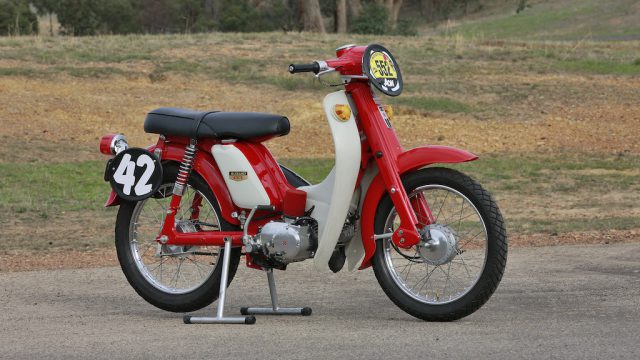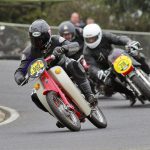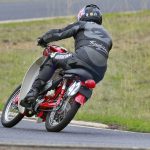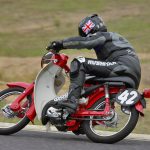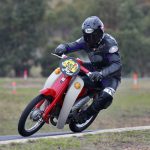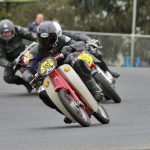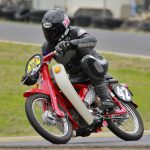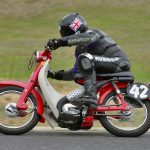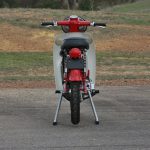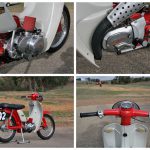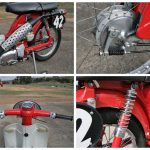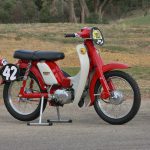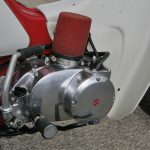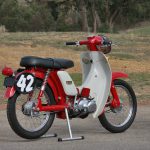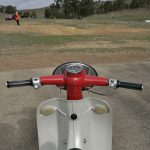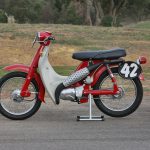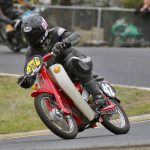Track test at Australia’s annual Broadford Bike Bonanza of the ultimate wacky racer
Imagine yourself out on the racetrack somewhere Down Under 45 years ago, riding Yamaha’s first-ever twin-cylinder 125GP customer racer, the TA125. You’re running up front in the 125cc field, trying your best to keep pace with the leaders – but then suddenly, without any warning, you’re zapped on the brakes in a twisty stretch of track by someone sitting bolt upright on a bright red bike, the sight of which makes you do a double-take. Why so? Because he’s riding a Suzuki Stepthru scooter, that’s why – a bike that has absolutely no right to be there beside you on the race track in the first place, let alone running so hard, up at the pointy end of the field. Better get used to it, though, mate – for back then loads of people had to put up with their purpose-built racebikes getting beaten by Graeme Laing on his tuned-up 115cc Suzuki SuperStepthru!
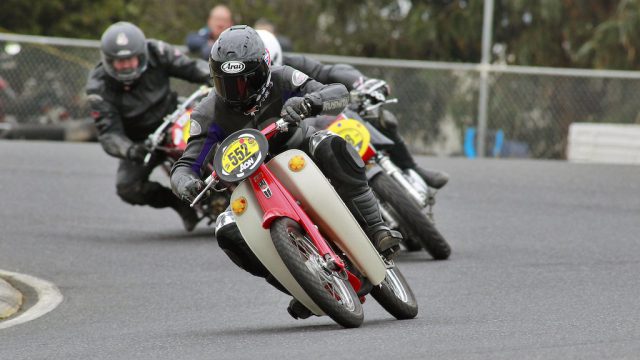
Dare to be different when going racing, and you’ll get noticed. But if you can race up front with something different that’s also improbably effective, that’s a double dare that can pay off well, promotionally speaking. That was the reasoning back in 1970 which led Australian Graeme Laing, founder/CEO of the Melbourne Motorcycle Company which was the Victorian distributor for Suzuki motorcycles, to cover both sides of the equation by going racing to establish the potential of the Japanese brand, which back then was very much the poor relation of its rival Honda and Yamaha compatriots in world markets. Indeed, until the debut of the T500 air-cooled parallel-twin in 1968, Suzuki didn’t make any customer bike bigger than its 250cc T20, plus in Australia the brand had no sporting credentials at all to speak of – so Laing set about acquiring some.
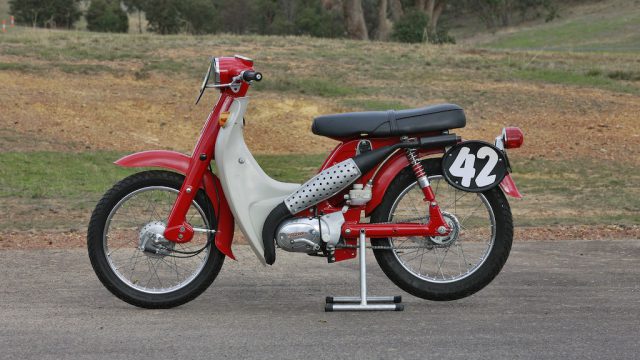
In 1969 Laing entered Peter Jones, his fledgling company’s fitter/mechanic and later its Service Manager, in the Australian TT at Surfers Paradise, and was rewarded with a literally incredible hat-trick of victories in Australia’s most important race meeting, back in those pre-Aussie GP days. For Jones won the 250cc, 350cc and 500cc TT races on the MMC-entered quarter-litre two-stroke twin, and on top of that finished third in the Unlimited race against bikes more than double its capacity. Having established to his customers that Suzuki produced a pretty good performance package, Laing then decided to go racing himself in the 125cc class on – a tuned F50 Stepthru scooter, fitted with a factory race kitted-motor!
Conceived by Laing to promote interest in the Suzuki brand, then overshadowed by Honda and Yamaha as it struggled to gain traction in the Australian market
Peter Jones takes up the story. “I first met Graeme when I joined the Sandringham Motorcycle Club back in early 1960's and we became friends. In 1965 he started Melbourne Motorcycles, and initially employed me to help him assemble the first shipment of Suzukis ever to reach Victoria over the Christmas period in 1965-66. I managed to do that without too many hiccups, so he offered me a full time job as the assembler cum mechanic, and I became the company’s second employee. This was the start of an association that lasted through the entire life of MMC from 1965 to 1982, when Suzuki Australia took it over. I and other staff members were fortunate to work in an atmosphere where racing bikes was actually enjoyed, not just tolerated, thanks to Graeme competing himself. I had a lot of success with the TR250, and our subsequent efforts with the TR500 GP racer, and finally the square-four RG500, saw all expenses taken care of. To say I was in a fortunate position would be an understatement – but it all came from the boss!”
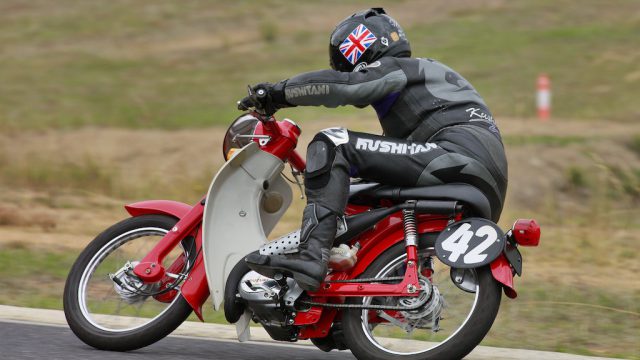
Slim and lanky, but also light, Graeme Laing was already a useful club racer who’d begun racing in 1958 on a tuned BSA Bantam, so after kickstarting Melbourne Motorcycles he began racing a pressed-steel framed A100 in 1967 in his spare time between trying to establish Suzuki in the Australian marketplace. This was fitted with a factory race kit originally developed for motocross, for it was surely unlikely the Suzuki factory could ever have expected anyone to road race an A100 even halfway seriously! This was an affordable rotary-valve runaround which sold in good numbers from 1966 to 1976, and the race kit gave it heaps more performance, presumably using lessons learnt from Suzuki’s 50/125cc disc-valve GP racers on which Kiwi Hugh Anderson won four World Championships in 1963-65. These all employed rotary-valve technology purloined from Communist East Germany’s MZ, after its star rider Ernst Degner defected to the West and thence to Japan in 1961, complete with MZ engineer Walter Kaaden’s technical secrets.
Engine is fitted with factory race kit aimed at motocross, producing 17 bhp in 50 x 50 mm 98cc A100 guise, up from 9.5 bhp originally
The A100 started off in life as a 50 x 50 mm air-cooled rotary-valve 98cc single-cylinder road bike, but according to US Suzuki Technical Bulletin No.2, dated August 1st 1969, fitting the race kit resulted in an increase in output to 17 bhp, almost twice the standard A100’s 9.5 bhp. That race kit was pretty extensive, consisting of a re-ported cylinder with a T-shaped bridged exhaust port, plus a new crankcase disc valve, a revised cylinder head, a larger 20mm Mikuni carburettor, an uprated piston, internal rotor CDI ignition, an expansion chamber exhaust, a set of closed-up ratios for the four-speed gearbox, and a small separate oil tank to contain the lubricant needed for Suzuki’s CC! Posi-Force Injection system. This directed oil to the crankshaft bearings and cylinder walls via an oil pump gear-driven off the crank, rather than the more conventional fuel-oil mixture. Peter Jones recalls Graeme Laing asking the Suzuki factory in 1967 if it was possible to increase the capacity of the A100’s 98cc motor to 125cc, to which they replied; ”It is not designed for conversion to 125cc racer from the beginning”. So there!
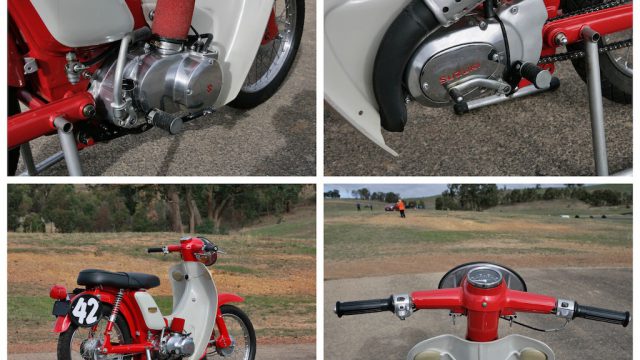
However, early in 1969 Graeme again asked Suzuki for their thoughts on over-boring the A100 cylinder to 54mm via a T20 Wiseco piston, thus achieving 115cc in order to make up for the A100 motor’s 20% capacity handicap, and also if they could suggest any mods that might improve handling. “We have already tested [the increase in capacity] several times,” came the reply. “However, decrease of the thickness of the cylinder sleeve from 4mm to 2mm caused the thermal deformation on the cylinder sleeve, resulting in serious piston seizure trouble,” However they also added; ”To overcome this problem we have made the special cylinder, the sleeve of which is 3mm in thickness. We can supply you two sets of these if you want. But, Wiseco piston and ring cannot be fitted on the above mentioned cylinder because of unsuitable position of the knock pins for the piston ring. It seems to be difficult to alter the position of the knock pins of Wiseco piston, so we would suggest you to employ the standard piston for T20, and change the position of the knock pins as illustrated below, to prevent the piston rings from being damaged on the transfer and third transfer ports. In this case, of course, you have to use the piston rings and piston pin for T20. And it is also necessary to cut the skirt of the piston by 4mm to prevent the piston from touching the crankshaft.”
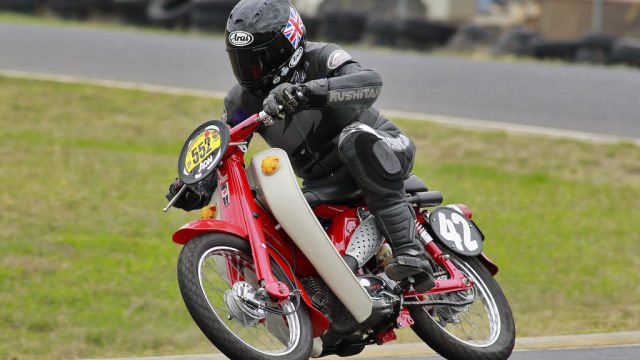
Suzuki also had some suggestions for improvements to the handling, which was to replace the standard rubber bushes in the swingarm with metal bushings, and they even supplied part numbers for the required components. They also furnished diagrams suggesting the location of gussets on the frame and swingarm to increase rigidity, adding that: “Our sole distributor in Venezuela has succeeded in improving handling and stability with the employment of Ceriani front forks and Girling rear shocks.” So Graeme Laing wasn’t alone in going road racing with an A100…!
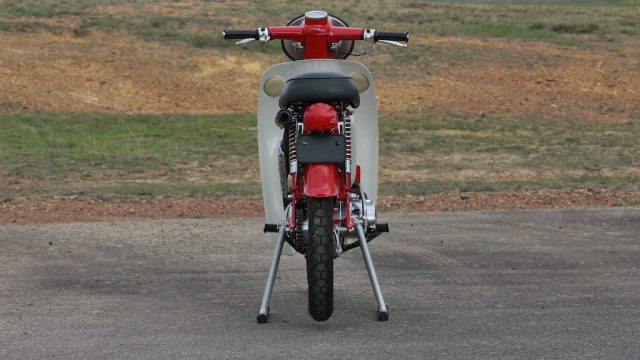
However, Graeme’s priority was the engine, and so he immediately ordered the proffered cylinders and asked what cylinder head mods were needed due to the increase in capacity. The cylinders were supplied, with an explanation as to the required cylinder head modifications. Graeme did in fact change the location of the ring pegs in a Wiseco piston, and the resulting 115cc A100-2 became a very successful 125cc class contender. The increase in performance plus three seasons of fettling the little two-stroke allowed Laing to win at Hume Weir in 1970, defeating Len Atlee, a front runner in the Aussie 125cc category on the CSD Yamaha, and he finished second to future Isle of Man Classic TT winner Bill Horsman's rapid TSS125 Bultaco at Winton among several other top five finishes against the best in Australia back then.
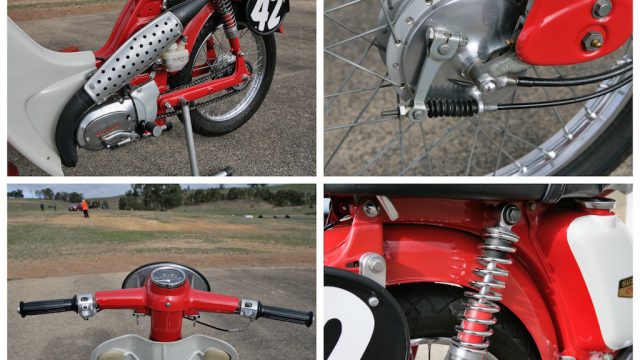
But although the little 115cc Suzuki A100-2 was now pretty competitive, with a keen eye on the promotional benefits Laing hit on the idea of running a Suzuki F50 Stepthru in the 125cc class in 1971, fitted with the tuned A100-2 engine. In an interview with REVS magazine his attitude was quoted as being "If you can't win, you may as well make a spectacle," but on this unlikely machine, Graeme managed to do both. After effecting the transplant he took the result to Calder Raceway, where it went remarkably well first time out, considering the rolling chassis was pretty much dead standard. Laing then went to Phillip Island's annual New Year's Day meeting in 1971, and just to make sure he got noticed racing what was already a pretty much standout machine, he wore a lounge suit (including collar and tie!) over his leathers, which attracted much hilarity! Next outing for the SuperStepthru was at McNamara Park just over the state border in South Australia, where Graeme once again turned out in his lounge suit, dressed for a business lunch. However, in stepped the spoilsport Victorian ACU under whose permit the meeting was run, whose officials decreed that what they termed "dressing up" was not in the best interests of the sport, and henceforth banned him from appearing in business attire. In their defence the ACU claimed that they’d received complaints from spectators about "the man on the scooter racing without protective leathers". As if!
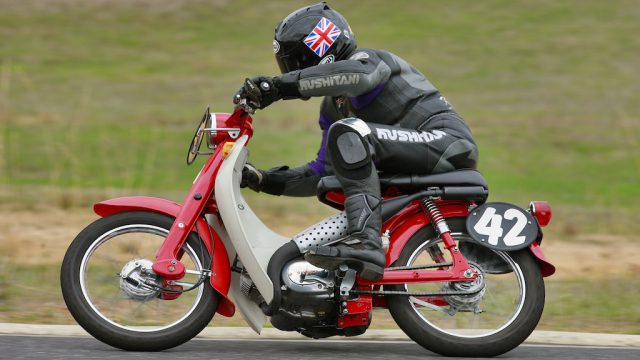
For the next couple of years the SuperStepthru became a firm crowd-pleaser wherever it turned out, and Graeme found the properly fettled underbone-framed Suzuki was fast enough to have fun on. It was competitive enough to regularly finish in the top five, although the advent of the more potent Yamaha AS3 twins and the later TA125 customer road racer meant the 115cc A100 single was now down on power. But it was super-reliable, with its only two DNFs coming when Laing fell off it in the wet at Calder, and he ran over another rider who fell in front of him, again at Calder. An occasional change of rings and a new set of points would freshen the motor up, and its handling was apparently quite reasonable, although with an ultra-short wheelbase of just 1040mm it must have got pretty lively over bumps. Peter Jones says Laing planned to fabricate a longer swingarm to resolve this, but with a thriving business to run and lots of other bikes to race, including the new water-cooled GT750 triple, he never got round to it. Graeme eventually sold the A100-engined SuperStepthru to Rod Ward, a Melbourne University Motorcycle Club member, who in turn later sold it to a fellow member, Duncan Simons, and he raced it occasionally until it needed an engine rebuild.
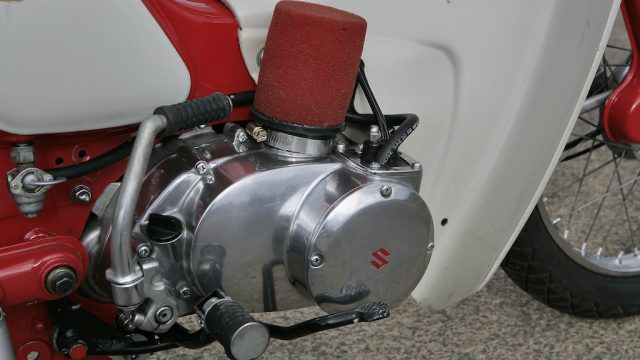
To do this he gave the motor to Peter White, a mechanic at a local bike shop whose uncle David was until recently MA/Motorcycling Australia’s CEO. “I’ve always had a Stepthru fetish!” admits Peter, “I first saw the Suzuki racing when I was 14 years old, and I fell in love with it then. I had a Honda C90 myself, and I really used to admire Graeme Laing's riding on the Suzuki – I saw it heaps of times at the Calder meetings. When I rebuilt the engine for Duncan I told him that if it was ever for sale, I wanted it. But he wouldn't sell it, and then he went and loaned it for someone to ride at Broadford. The clutch was slipping and this bloke was mistreating it, so when it came back to me again for repairs I said to Duncan, 'You're not getting it back – give me a ring when you work out how much you want for it!’” Money changed hands in 1993, but soon after Peter White's own racing career came to a temporary halt. "I was testing a customer's Kawasaki ZX10 when I hit a car and went over it, then collected another car coming the other way. I broke my back, and didn't ride anything for ten years." But in 2005, with the SuperStepthru now restored during his layoff, Peter entered it for the Australian Historic Championships at Symmons Plains in Tasmania. "This was only the fourth time I’d ridden it. I’d done three meetings at Broadford, and qualified on pole for the 125cc race every time,” he says. “In Tasmania I qualified second, and ended up fourth.”
Twin-shock F50 Stepthru cycle parts are completely unmodified, with stock 120mm drum brakes front and rear, and standard suspension
For such a competitive if decidedly unusual machine, the stepthru Suzuki is in basically stock condition, according to Peter. “It still has the original suspension and brakes – even the shoes in the standard F50 drum front brake are the original ones, and the speedo drive and speedo cable are connected and working. The bodywork is original, and all I’ve replaced is the nacelle and the rear mudguard. It came with a spare race kit cylinder and close-ratio gearbox, which I still have, and it’s almost as fast as a TA125. But first gear is quite high, so you lose five seconds off the line, and then have to try to make it up in the corners. I weigh a bit more than Graeme Laing did, too – more than the bike, in fact. It only weighs 67kg!”
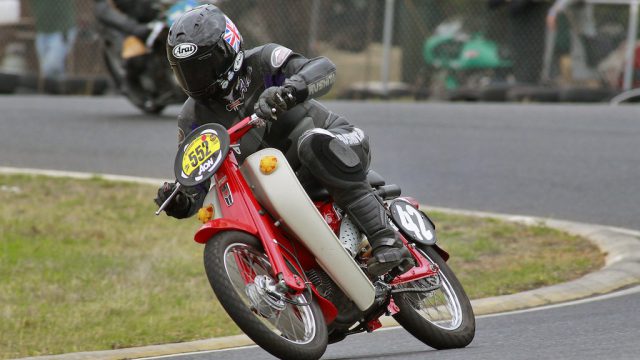
It weighs less than me, too – a fact I came to appreciate when Peter let me loose on this uber-underbone for 15 laps of the 2.16km switchback Broadford road racing circuit at the annual Bike Bonanza, and I spent most of the first couple of laps on it laughing out loud inside my Arai at the sheer improbability of it all. I’ve ridden some pretty wacky racers in my time, but very definitely nothing even remotely as improbable, so far out of left field, as the SuperStepthru Suzuki. It isn’t the fact that it’s so clearly designed to do something quite else than whiz round a racetrack, as the fact that it does indeed do this so very well. The way I zapped past a 350cc Manx Norton in a straight line with twice the horsepower but also more than double the weight of the little two-stroke single, gave me a hint of the performance available, and it’s evident that the 17 bhp output quoted in that US Suzuki Technical Bulletin for the race kitted 98cc A100 motor has been comfortably exceeded, thanks to the 2mm overbore to 115cc.There’s no tacho, but you can feel when it’s time to shift gear when the power flattens out at what I presume is around 8,000 rpm, though I kept a couple of fingers on the light-action clutch lever, just in case I’d got it wrong, and it might object to being overrevved. The left-foot gearshift lever is tucked tight close in, and it’s so very quick in operation with such a short travel that you only need to just graze it with your boot to shift gear. First gear is indeed very high, so you have to slip the clutch quite a bit to keep it in the powerband off the line or exiting a slow turn, but after that the next three ratios in the four-speed gearbox are more evenly spaced. The only instrument is the original speedo, which since it only reads to 100 kmh saw the needle off the dial for most of the lap!
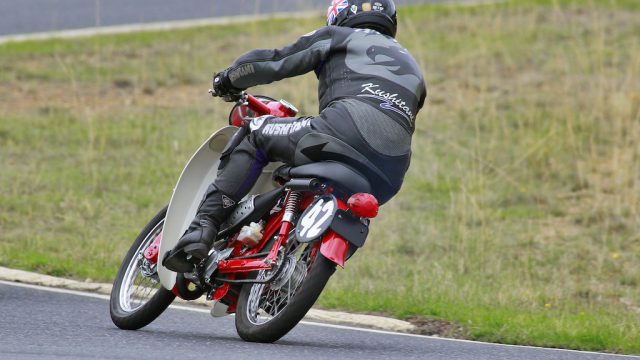
The Suzuki is indeed way short and pretty slim, with the knee guards giving a false impression of width at rest that completely disappears when you straddle the long, narrow seat and kickstart the engine with your right foot. In spite of the silencer fitted – Graeme Laing only ever raced the bike with a stinger exhaust devoid of one – there’s a potent-sounding crack from the exhaust that runs rearwards inside your left leg. Though inevitably close-coupled the riding position is actually super-rational, because you can slide back on the seat to tuck down behind the handlebar nacelle in a straight line, then move forward to sit upright in turns and under braking for them. This is not the bike’s strong point, because you must use both of the puny 120mm SLS drum brakes very hard to get any degree of retardation, and inevitably they started to fade after three hard stops in succession each lap in the Broadford infield, only to recover down the two long straights – well, by Stepthru standards they are! You really have to plan ahead stopping the SuperStepthru, because the brakes are really marginal for what is an unexpectedly fast bike for what it is – or, strictly speaking, once was! Gravity’s a good aid, though – so the uphill second-gear Turn 1 at Broadford invites you to chuck the Suzuki into the apex, and let the incline finish off the braking for you as you get back on the power again for the downhill drive out onto the main straight. Nice.
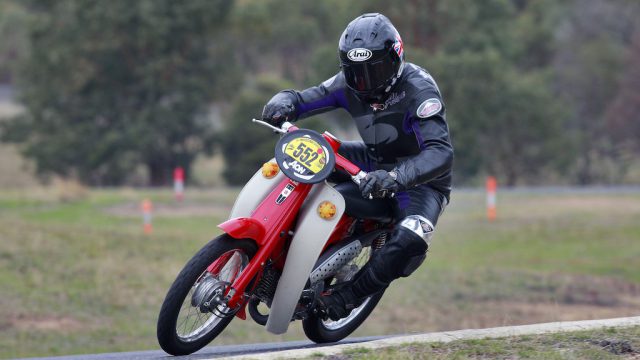
However, that’s not a word I’d use to describe the SuperStepthru’s handling, which is very much an acquired taste. It seems super skittish and ultra-nervous at all times – stability is a relative term, especially when the front end gets light plunging down over the pair of ramps along the main straight at Broadford, and it starts shaking from side to side. My first few laps on it were spent coming to terms with this, and learning not to oversteer into a bend thank to the ultra-light fingertip steering. This is after all one step up from a motorised pushbike, hence the nervousness. But I eventually got used to it, and that’s when I stared giggling to myself again inside my helmet at the improbability of it all. Flicking through the downhill Broadford Esses almost on auto-pilot then braking late – no choice! – into the 180º horseshoe Paddock turn was especially satisfying, particularly with the surprisingly good grip of the Michelin M45 tyres fitted.. The trick is to convince yourself you’re riding a proper racebike, which the Suzuki surely is, and ride it accordingly. But always with a smile….
One of the most unlikely road racers yet built, a race-winner both back then and today in 125cc Classic racing with current owner Peter White, as well as looking way wacky!
For this laugh-a-minute lightweight must have been huge fun to race – and still is, says Peter White, though there’s just one regret. “Back in 1995 I used Graeme Laing getting vetoed from wearing his business suit over his leathers as an inspiration for getting a set made where the top looks like a tuxedo, with black trousers below,” he says. “It came complete with a bow tie, and a handkerchief in the pocket! I actually won my first-ever race on the Suzuki in them, and I’ve still got them – but sadly, like so many leathers, they shrink if you leave them in a room for too long, and that’s why I can’t wear them anymore!” Ah, tempus fugit….
